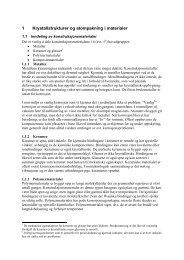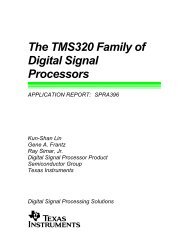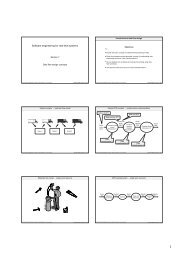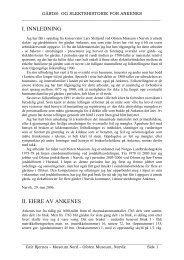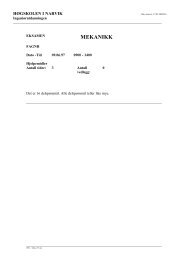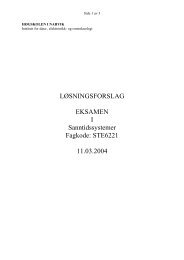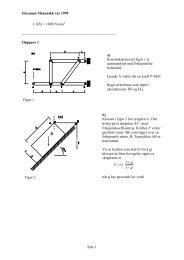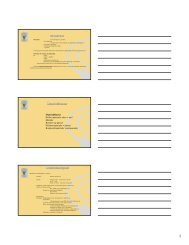Project concerning modern theory
Project concerning modern theory
Project concerning modern theory
You also want an ePaper? Increase the reach of your titles
YUMPU automatically turns print PDFs into web optimized ePapers that Google loves.
<strong>Project</strong> in Partial di¤erential equations -<br />
Assignment 2<br />
given by Dag Lukkassen<br />
The compulsory assignment must be formed as a scienti…c report, with table<br />
of contents, summary, references, pictures, page numbers, etc. max. 10 pages<br />
with 12 pt. text size. The problem will be dependent of a parameter s which is<br />
determined by the student as follows:<br />
s =<br />
(Your mothers age) (Your age)<br />
:<br />
20<br />
Note that each subtask task must be performed by each student individually<br />
without using any parts done by others. Recall that the …nal report must be<br />
attached to the examination paper. For the Ansys task below, a print of the<br />
log…le from Ansys must be attached to the report.<br />
1 Torsion of unbrako fastener<br />
An allen-wrench (also called unbrako fastener) is usually de…ned as a L-shaped<br />
bar with a hexagonal head, used to turn screws with hexagonal sockets (see<br />
Figure 1). However, for simplicity we will consider the case of an allen-wrench<br />
with quadratic head , of which we are going to calculate the torsional rigidity.<br />
In order to do this we have to solve the following partial di¤erential equation:<br />
8<br />
<<br />
:<br />
@2u @x2 +<br />
1<br />
@2u @x2 2<br />
= 2 x = (x1; x2) 2 ;<br />
u = 0 on @ ;<br />
where is the quadrat = [ s; s] 2 (see Figure 2):<br />
a) Find the corresponding weak formulation of (1), and explain why this formulation<br />
has a unique solution.<br />
Figure 1: Allen-wrench with a hexagonal head<br />
1<br />
(1)
Figure 2: Allen-wrench with a quadratic head<br />
b) Find a numerical solution of the above problem by using the …nite element<br />
method presented for the 2-dimensional case in the compendium with N = 3<br />
(i.e. use the triangulation with 3 3 interior nodes and h = s=2): Note that in<br />
order to …nd the numerical solution you have to solve a problem of the type<br />
A = b:<br />
This problem can easily be solved (e.g. by using the program Scienti…c Workplace)<br />
after you have found the sti¤ness matrix A and the vector b. The matrix<br />
A is found exactly as in the lectures. For the computation of b, note that<br />
each component bi can be found by …rst calculating the volume of the pyramid<br />
bounded by the x1; x2 plane and the shape of the basis-function vi.<br />
c) When the allen-wrench is subject to a torque T; the cross section parallel<br />
with the x1; x2 plane and at distance x3 from the x1; x2 plane will be rotated at<br />
an angle x3: The parameter is called the relative twist. The torsional rigidity<br />
is de…ned by<br />
It is possible to show that<br />
= T :<br />
Z<br />
= 2G<br />
u dx;<br />
where G is the shear modulus of the material and u is the solution of (1). Find<br />
an approximate value of for the case when G = 1 by using the numerical<br />
solution found in b).<br />
2
d) The problem (1) is of the same type as the heat conductivity problem for<br />
which the conductivity = 1 and u denotes the temperature. The thermal<br />
energy E is given by<br />
E = 1<br />
2<br />
Explain why the torsional rigidity<br />
Z<br />
jgrad uj 2 dx = 1<br />
Z<br />
2<br />
= 2GE;<br />
jgrad uj 2 dx:<br />
e) Use the FEM-program Ansys to solve the above problem more accurately<br />
than above by using a much larger …nite dimensional function space consisting<br />
of quadratic polynomials (8 node elements called plane77 with element edge<br />
length 0.07). In particular, …nd the torsional rigidity for the case when G = 1<br />
by calculating the thermal energy E and then multiply with 2 (as shown in<br />
the previous subtask). Compare with the value you found in b). A print of<br />
the log…le from Ansys must be attached to the report. Since you may not be<br />
familiar with Ansys we add some step by step guidelines in the Appendix below:<br />
f) The shear stresses 13 and 23 of the allen-wrench near its head are given by<br />
13 = G @u<br />
; 23 = G<br />
@x2<br />
@u<br />
:<br />
@x1<br />
Illustrate 13 and 23 by plotting the gradient of u (the ”temperature”) in x1<br />
and x2 direction. Where in is it most likely that the material fail?<br />
2 Appendix (step by step guidelines for the Ansys<br />
task)<br />
Before you start Ansys, turn o¤ Norman Virus Control (stopp sanntidssøkning).<br />
Start Ansys launcer, choose to save the …les on C:n<br />
Preferences: thermal, OK<br />
Preprocessor: Element Type: Add, Add, Thermal solid, 8 node 77 (=plane77),<br />
ok, close<br />
Preprocessor: Material Props: Material Models: material model number 1:<br />
Thermal; Conductivity, isotropic, conductivity KXX=1, ok.<br />
Preprocessor: Modelling: create, areas rectangle, by dimensions (sidelengths=4<br />
! x1 = s, x2 = s, y1 = s; y2 = s), ok.<br />
Preprocessor: Meshing, size cntrls, manual size: global, size, SIZE Element<br />
edge length 0.07. ok.<br />
File: write db log …le: test.lgw, ok. File save as jobname.db. ok<br />
Preprocessor: Mesh, areas, free, click on area with the mouse, ok.<br />
Save db.<br />
Solution, De…ne loads, apply, thermal, temperature, on lines, click on all four<br />
boundary lines with the mouse, OK, Lab2=Temp, Value Load TEMP value= 0:<br />
3
Solution, De…ne loads, apply, Heat Generat, On areas, click on the area with<br />
the mouse, iok, VALUE Load HGEN value = 2,ok.<br />
Solution, solve, current LS, OK, Solution is done!close.<br />
General Postproc, Read results, Last set.<br />
General Postproc, Element table, De…ne table, add, Lab=energy, Item,<br />
Comp Results data item = energy, ok. Close.<br />
General Postproc, Element table, Sum og each item, Energy= .......<br />
General Postproc, Plot results, Contour plot, nodal solu, Nodal solution,<br />
Thermal Gradient, x-component of thermal gradient, ok. (example).<br />
General Postproc, Plot results, Contour plot, nodal solu, Nodal solution,<br />
DOF solution, Temperature OK. (example).<br />
File: write db log …le: test.lgw, ok. File save as jobname.db. ok<br />
File exit.<br />
4



